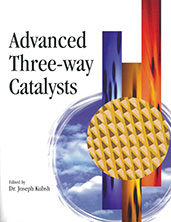Journal Article
Evaluation of a Gasoline Particulate Filter to Reduce Particle Emissions from a Gasoline Direct Injection Vehicle
2012-09-10
2012-01-1727
Gaseous compounds, particle number and size distribution measurements on a gasoline direct injection (GDI) vehicle and a port fuel injection (PFI) vehicle were conducted over the U.S. Federal Test Procedure 75 (FTP-75) and US06 Supplemental Federal Test Procedure (US06) on Tier 2 certification gasoline (E0) and a 10% by volume ethanol (E10). Overall the GDI test vehicle was observed to have lower fuel consumption than the PFI test vehicle by 6% and 3% for the FTP-75 and US06 drive cycles, respectively. When using E10, this GDI vehicle had a better fuel consumption than the PFI vehicle by 7% and 5% for the FTP-75 and US06 drive cycles, respectively. For particle emissions, the solid particle number emission rates for the GDI, equipped with a 3-way catalyst in its original equipment manufacturer configuration (i.e., stock GDI), were 10 and 31 times higher than the PFI vehicle for the FTP-75 and US06 drive cycles, respectively.

